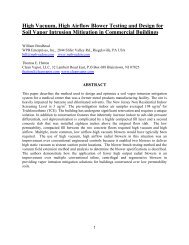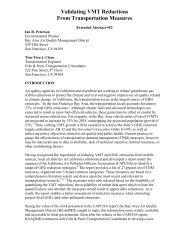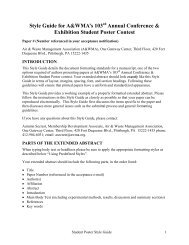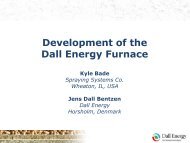Abstract Book
Abstract Book
Abstract Book
You also want an ePaper? Increase the reach of your titles
YUMPU automatically turns print PDFs into web optimized ePapers that Google loves.
measurements were integrated with modelling techniques to construct a more detailed<br />
picture of complex wind flow patterns.<br />
Advanced Dispersion Modelling Of Winter Particulate Matter From Localised<br />
Emission Sources In Rural New Zealand (33)<br />
B. Khan, T. Appelhans, P. Zawar-Reza, A. Sturman; University of Canterbury,<br />
Christchurch, New Zealand<br />
This study investigates the utility of advanced dispersion modelling techniques with The<br />
Air Pollution Model (TAPM) in small townships of New Zealand. Data assimilation<br />
techniques and an ensemble of scenarios were used to find the key parameters for better<br />
simulating high ground level concentrations from emissions into an extremely stable<br />
nocturnal surface-layer. Since the preferred method of home heating in rural areas of<br />
New Zealand is based on solid fuel burning, concentrations of PM10 exceed National<br />
Environmental Standards (NES) in many locations. TAPM is used to investigate<br />
particulate matter dispersion for two towns, the first, Reefton, is situated in a valley in the<br />
Southern Alps, and the second, Invercargill, is a somewhat larger coastal town at the<br />
southern tip of the South Island.<br />
The maximum PM10 concentration measured in Reefton is 129 µg m -3 and was recorded<br />
in June 2007. Domestic heating contributes around 93% of the daily winter PM10, with<br />
5% from outdoor burning, 1% from motor vehicles and less than 1% from industry. The<br />
maximum PM10 concentration measured in Invercargill is 198 µg m -3 , where the domestic<br />
heating contribution to daily winter PM10 emissions is 96%, with motor vehicles and<br />
industry contributing 2% each.<br />
Dispersion modelling with TAPM shows that it has a better success at capturing stability<br />
and wind profile characteristics in a setting where down-valley flow is more prominent<br />
(Reefton), than in the coastal town (Invercargill) where the model significantly<br />
overestimated the ground level concentrations. In this instance, TAPM was unable to<br />
faithfully reproduce local meteorology.<br />
Numerical Study On Dispersion Pollutant Emission Of Point Source In Urban<br />
Environment (103)<br />
M. Yassin; Kuwait University, Kuwait, Kuwait<br />
pollutant dispersion from point source was investigated numerically in an urban area.<br />
Numerical simulations were carried out using Computational Fluid Dynamics (CFD)<br />
models. The CFD models used for the simulation were based on the steady-state<br />
Reynolds-Average Navier-Stoke equations (RANS) with κ-ε turbulence models. A gas<br />
pollutant was emitted from a point source within the wake region behind the building<br />
model. The accuracy of these simulations was examined by comparing the predicted<br />
results with wind tunnel experimental data. Results indicated that there is a good<br />
agreement between the numerical simulation and the wind tunnel experiment for both<br />
wind flow and concentration diffusion. The results of this work can help to improve the<br />
10












